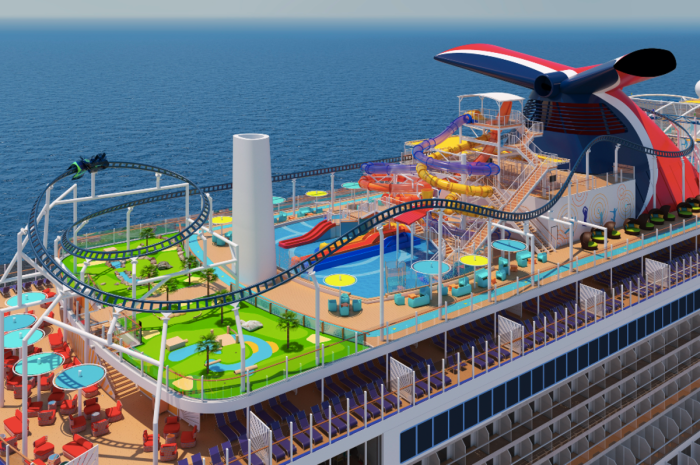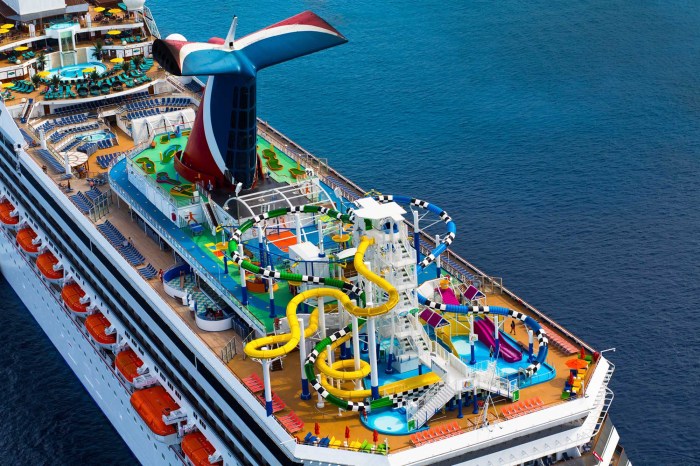Family Cruise Lines represent a booming sector of the travel industry, offering curated experiences designed to cater to the diverse needs and preferences of families. From toddlers to teenagers, cruise lines are increasingly tailoring their offerings to ensure memorable vacations for all ages. This exploration delves into the key considerations for families planning a cruise, examining everything from choosing the right line and itinerary to managing budgets and ensuring safety.
We’ll analyze the leading family cruise lines, comparing their amenities, pricing, and onboard activities. We’ll also explore the importance of careful planning, including budgeting for potential hidden costs and understanding safety protocols. Ultimately, the goal is to empower families to make informed decisions and create unforgettable memories on their next cruise.
Family Cruise Line Options
Choosing the right cruise line for a family vacation requires careful consideration of various factors, including budget, desired amenities, and the age range of children. The market offers a diverse range of options, each catering to specific demographics and preferences. Understanding these nuances is key to selecting the perfect family cruise experience.
Popular Family Cruise Lines and Their Target Demographics
Several cruise lines have established themselves as leaders in the family cruise market. Their success stems from tailoring their offerings to specific family needs and preferences. Disney Cruise Line, for example, caters specifically to families with young children, while Royal Caribbean International appeals to a broader range, including families with teenagers and adults. Other lines offer a balance between family-friendly activities and adult-focused amenities.
- Disney Cruise Line: Primarily targets families with young children, offering immersive Disney-themed experiences.
- Royal Caribbean International: Appeals to a wide range of families, from those with young children to multi-generational groups, boasting diverse activities and amenities.
- Carnival Cruise Line: Focuses on providing affordable, fun-filled cruises for families, with a wide array of casual dining and entertainment options.
- Norwegian Cruise Line: Offers a more flexible, freestyle cruising experience, appealing to families who value independent exploration and diverse dining choices.
- MSC Cruises: Caters to families with a blend of family-friendly activities and more adult-oriented entertainment, often offering competitive pricing.
Pricing Structures of Three Family-Focused Cruise Lines
Pricing for family cruises varies significantly across different lines and depends on factors such as cabin type, travel dates, and the number of passengers. Disney Cruise Line, known for its premium experience, tends to command higher prices compared to Carnival Cruise Line, which positions itself as a more budget-friendly option. Royal Caribbean International occupies a middle ground, offering a balance between price and amenities.
These price differences reflect the varying levels of service, amenities, and overall experience provided. For instance, a seven-day Caribbean cruise for a family of four might range from $3,000 on Carnival to $6,000 on Disney, with Royal Caribbean falling somewhere in between, depending on the specific itinerary and cabin selection.
Comparison of Amenities: Disney Cruise Line, Royal Caribbean International, and Carnival Cruise Line
The following table summarizes key amenities offered by three prominent family cruise lines. These amenities are crucial factors in determining the overall value and experience for families. Note that specific offerings can vary based on the ship and itinerary.
| Feature | Disney Cruise Line | Royal Caribbean International | Carnival Cruise Line |
|---|---|---|---|
| Character Meet & Greets | Extensive, themed experiences | Limited, depending on ship and itinerary | Generally limited to select characters |
| Kids’ Clubs | Age-specific clubs with Disney-themed activities | Comprehensive age-specific clubs with various activities | Age-specific clubs with a range of activities |
| Water Parks/Slides | Unique, themed water features | Large, impressive water parks with various slides | Generally smaller water parks with fewer slides |
| Dining Options | Character dining, themed restaurants, rotational dining | Diverse dining options, including specialty restaurants | Casual dining options, some specialty restaurants |
Onboard Activities and Entertainment
Family cruises are designed to provide a comprehensive and engaging experience for all ages, ensuring that every member of the family finds activities they enjoy. The onboard entertainment and activities are a significant part of this appeal, catering to diverse interests and age groups. A wide range of options, from dedicated children’s programs to family-friendly shows and adult-only options, ensures that there is something for everyone.
Children’s Programs
Family cruise lines invest heavily in age-appropriate programming for children. These programs are typically segmented by age group, providing a structured and supervised environment for kids to socialize, learn, and have fun. Many lines offer programs for toddlers, younger children, tweens, and teens, each with its own unique activities. Younger children might participate in arts and crafts, story time, and character meet-and-greets.
Older children often engage in more active games, sports tournaments, and themed events. Teens might find themselves enjoying video game tournaments, dance parties, and exclusive teen-only spaces. The specific offerings vary by cruise line, but the overall goal is consistent: to create a fun, engaging, and safe environment for children of all ages.
Family-Friendly Shows and Entertainment
Beyond children’s programs, family cruises boast a variety of family-friendly shows and entertainment. These often include Broadway-style productions, musical revues, comedy acts, and magic shows, designed to appeal to a wide range of ages. Many cruise lines also offer themed events, such as pirate nights or luau parties, that create a memorable and immersive experience for the entire family.
These events frequently involve interactive elements, encouraging participation from the audience and creating a sense of shared enjoyment. The quality and diversity of these shows vary depending on the cruise line and the ship, but most offer a compelling selection of entertainment options.
Age-Appropriate Activities
The cruise experience is meticulously designed to cater to different age groups. Toddlers and preschoolers typically find themselves in dedicated play areas with age-appropriate toys and supervised activities. Younger children might participate in structured games, arts and crafts, and interactive storytelling sessions. Tweens and teens often have access to their own dedicated spaces, complete with video games, movie screenings, and social events.
This age-segmentation ensures that children are appropriately challenged and engaged, preventing boredom and promoting a sense of belonging within their peer group. Adult-only areas and entertainment options are also available, providing parents with opportunities for relaxation and time away from the children.
Sample Seven-Day Cruise Schedule (Young Children)
A typical seven-day cruise itinerary for a family with young children might look something like this:
| Day | Morning | Afternoon | Evening |
|---|---|---|---|
| 1 | Embarkation/Ship Exploration | Kids’ Club Activities (arts & crafts) | Family Dinner/Ship Show |
| 2 | Pool Time/Character Meet & Greet | Kids’ Club Activities (games) | Family Dinner/Deck Games |
| 3 | Port Day (Family Excursion) | Port Day (Family Excursion) | Family Dinner/Movie Night |
| 4 | Kids’ Club Activities (story time) | Swimming/Water Slides | Family Dinner/Magic Show |
| 5 | Pool Time/Relaxation | Kids’ Club Activities (sports) | Family Dinner/Pirate Night |
| 6 | Port Day (Family Excursion) | Port Day (Family Excursion) | Family Dinner/Farewell Party |
| 7 | Disembarkation | – | – |
This is a sample schedule and specific activities will vary depending on the cruise line and itinerary. Flexibility is key, allowing families to tailor their experiences to their preferences and the children’s needs.
Dining and Culinary Experiences: Family Cruise Lines
Family cruises are increasingly recognized for their diverse and high-quality dining options, moving beyond the traditional buffet-style service to offer a range of choices designed to cater to the diverse palates and needs of families. This extends to dedicated children’s menus, specialized family dining experiences, and meticulous attention to dietary restrictions and allergies. The aim is to create memorable culinary moments for every family member, enhancing the overall cruise experience.Family Cruise Lines offer a variety of dining venues to suit different preferences and occasions.
From casual buffets with kid-friendly options to more formal sit-down restaurants, families can choose the atmosphere that best fits their mood and dining style. This flexibility is a key factor in making the cruise experience enjoyable for everyone.
Children’s Menus and Kid-Friendly Options
Many cruise lines provide dedicated children’s menus featuring familiar and appealing dishes, ensuring even the pickiest eaters find something they enjoy. These menus typically include classics like chicken fingers, mac and cheese, pizza, and pasta, alongside healthier options like grilled fish or fruit. The presentation of the food is often tailored to children, with fun shapes and colorful arrangements.
Many buffets also offer dedicated children’s sections with easily accessible food choices. Beyond the menus, many ships also offer kid-friendly snacks and drinks throughout the day, ensuring children are never left hungry.
Family-Oriented Special Dining Experiences
Beyond the standard dining options, many cruise lines offer special dining experiences designed specifically for families. These might include themed nights with character appearances, interactive cooking classes where children can learn to prepare simple dishes, or family-style meals served in a relaxed and convivial setting. These events create opportunities for families to bond over shared culinary experiences and make lasting memories.
For example, some lines might offer a pirate-themed dinner with a treasure hunt or a character breakfast with beloved cartoon figures.
Accommodating Dietary Restrictions and Allergies, Family Cruise Lines
Cruise lines are increasingly adept at catering to dietary restrictions and allergies, including those of children. Most ships have staff trained to handle specific dietary needs, and they often work closely with families to create customized menus that meet their children’s requirements. This may involve providing gluten-free, dairy-free, or allergen-free options, or preparing meals that accommodate other specific dietary needs.
Families are typically encouraged to inform the cruise line of any dietary restrictions or allergies well in advance of the cruise to allow for adequate preparation. Open communication is key to ensuring the cruise is a positive and safe experience for children with special dietary needs.
Sample Three-Day Dining Plan for a Family
A sample three-day dining plan might include:Day 1: Lunch at the buffet, offering a variety of kid-friendly options. Dinner at a family-friendly restaurant with a dedicated children’s menu, allowing for a more relaxed atmosphere.Day 2: Breakfast at the buffet. Lunch at a casual pizzeria. Dinner at a more formal restaurant, perhaps trying a family-style meal option.Day 3: Breakfast in the cabin (room service).
Lunch at the poolside grill. Dinner at a themed family dining experience, such as a pirate night. This variety ensures the family experiences the diverse culinary offerings of the ship.
Cruises Tailored for Families
Family cruises represent a significant segment of the travel market, offering a unique blend of relaxation, adventure, and quality time for families of all sizes and ages. The industry caters to this demand with diverse itineraries, onboard amenities, and pricing structures designed to appeal to parents and children alike. Careful consideration of several factors can ensure a memorable and stress-free family vacation at sea.
Popular Family Cruise Itineraries and Themes
The most popular family cruise itineraries often involve shorter sailings to destinations known for their kid-friendly attractions. Caribbean cruises, for example, frequently feature stops at islands with pristine beaches, water parks, and opportunities for snorkeling or other water sports. Alaska cruises offer breathtaking scenery and wildlife viewing opportunities, appealing to families interested in nature and adventure. Themed cruises, such as Disney cruises, provide immersive experiences with character meet-and-greets, themed activities, and shows tailored to children’s interests.
Cruises visiting multiple ports of call within a region also tend to be popular, offering variety and preventing boredom. Mediterranean cruises, for instance, allow families to experience the culture and history of several European countries in a single trip.
Benefits of Shorter Cruises for Families with Young Children
Shorter cruises, typically lasting three to five days, offer several advantages for families with young children. The reduced duration minimizes the risk of children becoming restless or overwhelmed during the voyage. Shorter trips are generally less expensive, making them more accessible to families with budget constraints. Furthermore, shorter itineraries can reduce the potential for seasickness, a common concern for some travelers, especially children.
The shorter timeframe also makes it easier to manage packing and pre-trip preparations. For instance, a family might choose a three-day Bahamas cruise rather than a seven-day Caribbean itinerary to minimize the demands on their time and resources.
Private Balcony vs. Inside Cabin for Families
The choice between a private balcony and an inside cabin significantly impacts the family cruise experience. A private balcony offers unparalleled privacy and stunning ocean views, providing a dedicated space for relaxation, enjoying meals, or simply watching the sunset. This extra space can be invaluable for families, especially those with older children who appreciate their own space. However, balconies come at a premium price.
Inside cabins, while more affordable, lack natural light and outdoor space. This can be particularly challenging for families with young children who may need more room to play and move around. The lack of fresh air and views can also lead to cabin fever, especially on longer cruises. Ultimately, the best choice depends on the family’s budget and priorities.
A larger inside cabin might be a more practical option for a large family compared to a smaller balcony cabin.
Factors to Consider When Selecting a Family Cruise Itinerary
Selecting the right itinerary is crucial for a successful family cruise. Several key factors should be considered:
- Destination: Choose a destination that aligns with the family’s interests and age range of the children. Consider factors like climate, activities available, and travel time.
- Cruise Length: Balance the desire for a longer vacation with the attention spans and needs of younger children. Shorter cruises may be preferable for families with toddlers or preschoolers.
- Ship Amenities: Look for ships with kid-friendly amenities such as kids’ clubs, pools, water slides, and age-appropriate activities. Consider the availability of babysitting services.
- Onboard Entertainment: Check the ship’s schedule for family-friendly shows, movies, and activities. Ensure there are enough options to keep everyone entertained.
- Dining Options: Assess the availability of child-friendly meals and dining options. Flexible dining times can be beneficial for families with young children.
- Budget: Set a realistic budget that accounts for the cruise fare, onboard expenses, excursions, and gratuities. Consider the cost of various cabin types.
Safety and Security on Family Cruises

Family cruises offer a unique blend of relaxation and adventure, but ensuring the safety and well-being of children is paramount. Cruise lines implement comprehensive security protocols and provide numerous resources to address potential concerns, creating a secure environment for families to enjoy their vacation. This section details the various safety measures in place, procedures for handling emergencies, and the importance of travel insurance.
Child Safety Measures
Cruise lines prioritize child safety through a multi-layered approach. Dedicated children’s programs often include age-appropriate activities supervised by trained staff members who undergo background checks. Many ships feature designated children’s areas with controlled access, ensuring a safe and secure environment for young passengers. Furthermore, enhanced security measures, such as CCTV monitoring in public areas and staff trained in child safety protocols, contribute to a safer onboard experience.
Wristbands or tracking devices may also be offered for children, enabling quick identification and reunification in case of separation. These measures aim to minimize risks and provide parents with peace of mind.
Procedures for Reporting Lost Children or Emergencies
In the event of a lost child, immediate action is crucial. Clear and readily accessible procedures are in place. Families should immediately report any missing child to the nearest crew member or the ship’s security office. Cruise lines utilize a coordinated response system, often involving public address announcements, staff searches, and potentially the deployment of ship-wide tracking systems to quickly locate the missing child.
In case of other emergencies, clearly marked emergency stations and readily available crew members are present throughout the ship. Emergency protocols, such as drills and training for crew members, ensure swift and effective responses to a range of potential incidents.
Importance of Travel Insurance for Family Cruises
Travel insurance is strongly recommended for family cruises. Unexpected events, such as medical emergencies, flight cancellations, or lost luggage, can incur significant costs. Comprehensive travel insurance can cover these unforeseen expenses, offering financial protection and reducing the stress associated with such situations. Specific policies can include coverage for medical evacuations, trip interruptions, and lost or stolen belongings, providing crucial support for families during unforeseen circumstances.
The cost of insurance is a small price to pay for the peace of mind it provides.
Essential Safety Tips for Families Traveling on a Cruise
Prior to embarking, families should familiarize themselves with the ship’s safety procedures and emergency protocols. This includes understanding the location of lifeboats, assembly stations, and emergency exits. During the cruise, parents should continuously supervise their children, especially near pools, water features, and open decks. It is crucial to establish meeting points in case of separation and to ensure children wear appropriate safety gear when participating in water activities.
Finally, teaching children basic safety rules, such as not talking to strangers and reporting any suspicious activity to a crew member, is crucial for their well-being throughout the voyage. These precautions contribute to a safer and more enjoyable cruise experience for the entire family.
Illustrative Examples of Family Cruise Experiences

Family cruises offer a unique blend of relaxation, adventure, and quality time, creating memories that last a lifetime. A well-structured itinerary, coupled with a range of onboard and onshore activities, caters to diverse family interests and age groups, ensuring an enjoyable experience for all. The following examples showcase the diverse possibilities available on a typical family cruise.
A Typical Day in the Life of a Family on a Cruise
A typical day aboard a family-friendly cruise ship might begin with a leisurely breakfast at the buffet, offering a wide array of options to satisfy even the pickiest eaters. Following breakfast, children might head to the kids’ club for supervised activities like arts and crafts, while parents relax by the pool or enjoy a spa treatment. The afternoon could involve a family game of mini-golf, followed by a swim in one of the ship’s pools.
Later, families might attend a family-friendly show in the theater, followed by dinner at a casual dining venue. Evenings often conclude with family time on the deck, stargazing, or enjoying live music. This structured yet flexible schedule allows for both planned activities and spontaneous moments of connection.
A Family-Friendly Shore Excursion: Exploring the Mayan Ruins of Cozumel
One popular shore excursion option for families is a visit to the Mayan ruins on the island of Cozumel, Mexico. This excursion typically begins with a comfortable bus ride to the San Gervasio archaeological site, where families can explore the ancient temples and learn about Mayan history and culture. Guides provide engaging narratives, tailored to different age groups, bringing the history to life.
Children might particularly enjoy the opportunity to imagine what life was like for the ancient Mayans. The excursion often includes opportunities for photography, allowing families to capture lasting memories amidst the impressive architecture and lush surroundings. The tour typically concludes with a refreshing swim at a nearby beach, providing a relaxing end to an educational and exciting adventure.
A Family Dinner at a Specialty Restaurant
Imagine the family gathered in a sophisticated yet warmly lit specialty restaurant aboard the ship. The aroma of freshly baked bread and the subtle sounds of gentle conversation create a relaxed atmosphere. The children, perhaps slightly more refined than usual thanks to the elegant surroundings, are engrossed in the unique menu, carefully selecting their dishes. The parents, enjoying a moment of respite from the day’s activities, savour the expertly prepared dishes, engaging in conversation as they appreciate the exquisite flavors.
The meal is more than just sustenance; it’s a shared experience, a highlight of the cruise, and a memory that will be fondly recalled long after the journey concludes. The attentive service and the high-quality food contribute to a truly memorable dining experience for the whole family.
Planning a family cruise requires careful consideration of various factors, but the rewards are immeasurable. From the convenience of all-inclusive amenities to the diverse range of activities and entertainment, a well-planned cruise can create lasting memories for the entire family. By understanding the nuances of different cruise lines, itineraries, and budgeting strategies, families can navigate the process effectively and embark on a truly enriching vacation experience.
The key is thorough research and a focus on selecting a cruise that perfectly aligns with the family’s needs and preferences.

